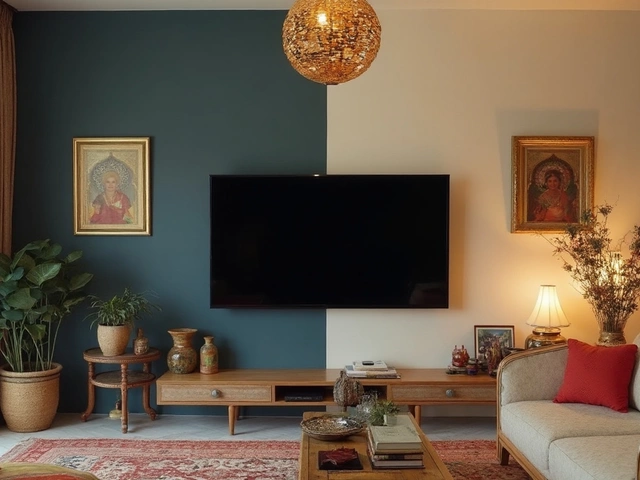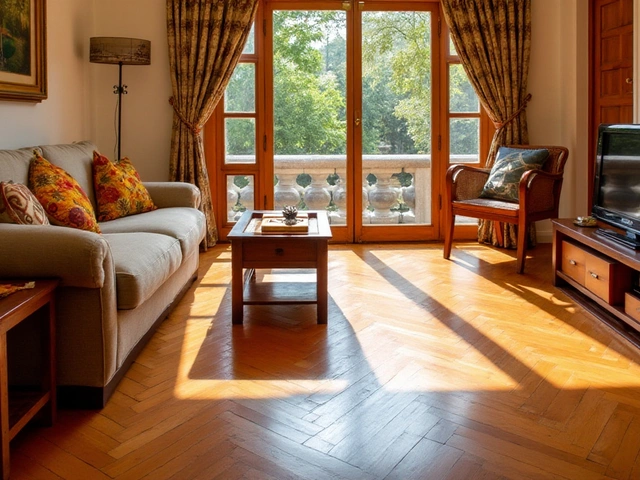Ever walk into your small house and feel like there’s just stuff everywhere? You’re not alone. The number one problem in tight spaces isn’t that there’s too much stuff—it’s that most people simply don’t use their space the right way. Here’s a game-changer: stop looking for more floor space, and start using the space you already have in smarter ways.
Walls aren’t just for hanging pictures. Think about all that empty space above your head. That spot over the door? Perfect for a narrow shelf. Even that awkward wall behind the couch can hold shelves or hooks. When you start thinking vertically, you’ll suddenly see your home as a storage playground—not a cramped box. Ready to find space you never even knew you had? Keep reading, and you'll see just how easy it is to get more from every inch.
Think Up, Not Out
If you’re short on square footage, it’s time to start treating your walls like gold. The trick? Use every vertical inch to free up that precious floor. Think shelves, wall hooks, pegboards, and tall cabinets—these things can double or even triple your storage space without taking up more room to walk.
You’ve probably seen gorgeous open shelves on Pinterest or Instagram. They’re not just for show. Add shelves up high in the kitchen for stuff you barely use, or line the hallway with slim shelving for books, baskets, or even shoes. One cool fact: a wall shelf just six inches deep is perfect for holding jars, canned food, and even rolls of paper towels. Stick some baskets up there and you’ve got an instant pantry.
Bedrooms offer more vertical storage options than you think. That space above your headboard or next to your closet door? Install a couple of floating shelves, or stack your hats, scarves, or laundry essentials up high. If you’re a collector, vertical display cases keep things organized and dust-free, while showing off your favorite finds.
Let’s break down some easy, no-drill ways to use vertical storage:
- Adhesive hooks for keys and bags—straight on your entryway wall.
- Stackable cube organizers—build them as tall as your ceiling allows.
- Over-the-door racks for shoes, cleaning supplies, or extra snacks.
- Pegboards in the kitchen or office for utensils or craft stuff.
Here’s how much extra space you can get just by adding wall storage in a typical small room (about 100 square feet):
| Wall Height (feet) | Usable Shelf Space Added (linear feet) | Potential Item Capacity* |
|---|---|---|
| 2 ft (above head height) | 26 ft (all four walls) | 40-60 books / 20 storage bins |
| 3 ft (more shelving up top) | 39 ft | 60-90 books / 30 storage bins |
| 4 ft (max for ladder reach) | 52 ft | 90-120 books / 40 storage bins |
*Based on average shelf and bin sizes
So before you buy another bulky storage bin, look up. Most small house problems disappear when you stack solutions sky-high. Use your small house storage space to its max, and suddenly, living tiny feels a whole lot bigger.
Hidden Spaces You Forget
Most people miss out on storage because they overlook the weird corners and underused spots in their homes. Let’s talk about those game-changing places that can hide more than you think. Under the bed? That’s classic, but so many folks just let dust settle there. Roll-out bins, flat plastic containers, or even extra drawers on wheels turn this dead space into a smooth spot for seasonal clothes, shoes, or linens. If you want easy access, consider a lift-up bed with built-in storage. IKEA literally made a business out of finding storage under beds and couches.
Doors deserve more respect. Seriously, the inside of a closet door or even your main entry door can hold racks for shoes, hooks for keys, or caddies for cleaning supplies. Brands like Umbra and Command design clever over-the-door organizers just for this purpose. You can stash scarves, bags, or even snacks for late-night kitchen raids right on the back of a door.
Corners are criminally underused. Corner shelves or triangular cubbies fit into those awkward angles where nothing else does, making them perfect for books, décor, or bathroom supplies. If you live in a small space, every inch counts—don’t leave corners empty just because standard furniture doesn’t fit.
Another winner? The gap between your fridge and the wall. If it’s more than a couple inches, you can grab a slim rolling cart for spices, snacks, or kids’ lunch boxes. Every home has weird gaps like this—just poke around and measure. You’ll be surprised by what you can squeeze in.
The small house storage mindset is about spotting oddball spaces and putting them to smart use. So next time you feel like there’s nowhere to stash your stuff, ask yourself: Are you missing a spot that’s right in front of you?

Multi-Tasking Furniture
Trying to fit a sofa, bed, desk, and storage in one small spot? Sounds impossible, but that’s where multi-tasking furniture changes everything. In a small house storage setup, every piece of furniture should pull double duty, or it doesn’t make the cut.
Let’s get specific. Beds with built-in drawers are a no-brainer—you're wasting prime real estate without them. Storage ottomans can hide winter blankets or board games, while giving you an extra place to sit. Coffee tables with lift tops are perfect for a late-night snack or working on your laptop, but inside, they swallow remotes, magazines, or whatever otherwise clutters up your living room.
Fold-out desks have surged in popularity; some even mount on the wall and disappear when not in use. Got kids? Go for bunk beds with shelves and built-in desks underneath. In the kitchen, a rolling cart adds bonus counter space and tucks into corners when you’re done.
- Choose a bed with storage drawers or lift-up base.
- Pick a bench or ottoman that opens up for hidden storage.
- Use nesting tables—they stack together when not in use but spread out for guests or projects.
- Opt for sofas with built-in storage underneath or a pull-out bed.
- Look for expandables, like dining tables that grow with company but shrink for daily life.
Check out the numbers below for some typical storage capacities you get from switching to multi-tasking pieces:
| Furniture Type | Storage Space Gained |
|---|---|
| Queen bed with drawers | Up to 16 cubic feet |
| Ottoman with storage | 2-5 cubic feet |
| Coffee table with lift top | 2-3 cubic feet |
| Bunk bed system | 4-10 cubic feet (shelves & desks) |
Don’t forget, the trick isn’t owning more—it's getting your existing furniture to work harder. If a piece can’t hide, hold, or fold, it might not deserve a place in your small home. Before you buy your next chair or shelf, ask yourself what else it can do beyond the obvious.
Declutter Like a Pro
Getting serious about a small house means facing a tough truth: there’s just no room for stuff you don’t use. Most people use only 20% of their things 80% of the time. That means the rest is taking up space for no good reason. So, decluttering isn’t just a trend—it’s a way to unlock hidden storage right now.
Start with one room at a time. Don’t get overwhelmed; just focus on what’s right in front of you. Grab three boxes or bins and label them “Keep,” “Donate/Sell,” and “Trash.” Then ask yourself with each item: Do I need this? Do I use this regularly? Or am I just keeping it out of habit?
- Pull out everything from closets and drawers. Dump it all on the bed or floor. Now you see exactly what you’ve got.
- Be honest—if something’s broken or doesn’t fit, it goes. If you haven’t used it in a year, it’s probably time to let it go.
- Scan for doubles. Can you get by with one set of mixing bowls instead of three?
- Good stuff you don’t use? Someone else probably needs it. Bag it for charity or sell online. Your loss is someone else’s gain.
- Everything left in your “Keep” pile gets a home—don’t just shove it back where you found it. Use bins, baskets, or drawer dividers so each item has a spot.
People don’t realize how much of their small house storage problem comes from simply having too much stuff. According to a 2024 survey by the National Association of Professional Organizers, 54% of Americans feel overwhelmed by clutter and don’t know where to start. Decluttering is step one, and it works wonders.
| Room | Average Unused Items |
|---|---|
| Kitchen | 23 |
| Bedroom | 18 |
| Living Room | 12 |
| Bathroom | 9 |
Source: 2024 National Home Organization Survey
One last trick? Set a reminder for “mini-declutter” sessions every couple of months. A quick sweep makes sure clutter never takes over again. You’ll find that letting go is the best way to make your home feel bigger and actually use the space you have.





